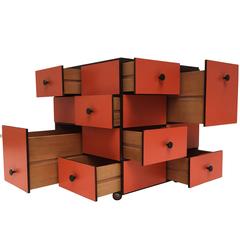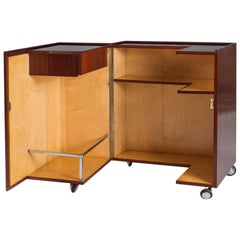Cini Boeri Cubotto
Recent Sales
Vintage 1960s Italian Minimalist Commodes and Chests of Drawers
Brass, Chrome
Vintage 1960s Icelandic Mid-Century Modern Carts and Bar Carts
Wood
Vintage 1960s Italian Mid-Century Modern Commodes and Chests of Drawers
Wood
Cini Boeri for sale on 1stDibs
Had Cini Boeri been a man, the Milanese architect and furniture designer, who died in 2020 at age 96, might be regarded today on par with such visionaries of the mid-20th century as Gio Ponti or Marco Zanuso. She worked with both. Although she’s well known and deeply respected in Italy, her renown elsewhere has been more akin to a cult following.
“I admire the work she did across architecture, interiors and furniture,” designer Faye Toogood says of Boeri’s impact. “She practiced architecture during a time when it was considered that women were too fragile to work outside.”
Boeri was one of very few women of her era to graduate from Milan Polytechnic with an architecture degree, which she did in 1951. Her illustrious career hinged on the strict economy of her designs and limited palette of materials. For example, her innovative 1971 Serpentone sofa for Arflex was crafted from just one material, polyurethane foam, and sold by the meter. Her ingenious 1987 Ghost chair for Fiam was cut from a single sheet of thick glass.
But in Boeri’s earlier days, her pieces displayed a more youthful exuberance. The circa 1968 Cubotto cabinet, produced in small numbers by Arflex, is an elegantly irregular arrangement of eight drawers of varying dimensions. The wooden cube, two feet square, was finished in laminate — in vivid orange, blue, sand or white — with color-coordinated casters and handles of black-enameled brass. Its design reflects a Space Age interest in flexible, space-saving, multiuse furnishings.
“It’s a very clean piece of design,” says Kaisha Davierwalla, owner and founder of Vaspaar Italy. “Even with its strong, square lines, somehow the vibrant colors and asymmetry have the feel of a feminine touch.”
Find vintage Cini Boeri seating, lighting and tables on 1stDibs.
Finding the Right Storage-case-pieces for You
Of all the vintage storage cabinets and antique case pieces that have become popular in modern interiors over the years, dressers, credenzas and cabinets have long been home staples, perfect for routine storage or protection of personal items.
In the mid-19th century, cabinetmakers would mimic styles originating in the Louis XIV, Louis XV and Louis XVI eras for their dressers, bookshelves and other structures, and, later, simpler, streamlined wood designs allowed these “case pieces” or “case goods” — any furnishing that is unupholstered and has some semblance of a storage component — to blend into the background of any interior.
Mid-century modern furniture enthusiasts will cite the tall modular wall units crafted in teak and other sought-after woods of the era by the likes of George Nelson, Poul Cadovius and Finn Juhl. For these highly customizable furnishings, designers of the day delivered an alternative to big, heavy bookcases by considering the use of space — and, in particular, walls — in new and innovative ways. Mid-century modern credenzas, which, long and low, evolved from tables that were built as early as the 14th century in Italy, typically have no legs or very short legs and have grown in popularity as an alluring storage option over time.
Although the name immediately invokes images of clothing, dressers were initially created in Europe for a much different purpose. This furnishing was initially a flat-surfaced, low-profile side table equipped with a few drawers — a common fixture used to dress and prepare meats in English kitchens throughout the Tudor period. The drawers served as perfect utensil storage. It wasn’t until the design made its way to North America that it became enlarged and equipped with enough space to hold clothing and cosmetics. The very history of case pieces is a testament to their versatility and well-earned place in any room.
In the spirit of positioning your case goods center stage, decluttering can now be design-minded.
A contemporary case piece with open shelving and painted wood details can prove functional as a storage unit as easily as it can a room divider. Alternatively, apothecary cabinets are charming case goods similar in size to early dressers or commodes but with uniquely sized shelving and (often numerous) drawers.
Whether you’re seeking a playful sideboard that features colored glass and metal details, an antique Italian hand-carved storage cabinet or a glass-door vitrine to store and show off your collectibles, there are options for you on 1stDibs.

